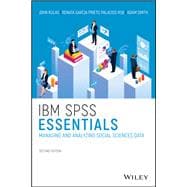Master the fundamentals of SPSS with this newly updated and instructive resource
The newly and thoroughly revised Second Edition of SPSS Essentials delivers a comprehensive guide for students in the social sciences who wish to learn how to use the Statistical Package for the Social Sciences (SPSS) for the effective collection, management, and analysis of data. The accomplished researchers and authors provide readers with the practical nuts and bolts of SPSS usage and data entry, with a particular emphasis on managing and manipulating data.
The book offers an introduction to SPSS, how to navigate it, and a discussion of how to understand the data the reader is working with. It also covers inferential statistics, including topics like hypothesis testing, one-sample Z-testing, T-testing, ANOVAs, correlations, and regression. Five unique appendices round out the text, providing readers with discussions of dealing with real-world data, troubleshooting, advanced data manipulations, and new workbook activities.
SPSS Essentials offers a wide variety of features, including:
- A revised chapter order, designed to match the pacing and content of typical undergraduate statistics classes
- An explanation of when particular inferential statistics are appropriate for use, given the nature of the data being worked with
- Additional material on understanding your data sample, including discussions of SPSS output and how to find the most relevant information
- A companion website offering additional problem sets, complete with answers
Perfect for undergraduate students of the social sciences who are just getting started with SPSS, SPSS Essentials also belongs on the bookshelves of advanced placement high school students and practitioners in social science who want to brush up on the fundamentals of this powerful and flexible software package.








